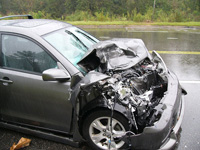DEFENDING THE 90/180 DAY CLAIM IN A NEW YORK AUTO CASE
03/09/15

Few issues in New York have generated more conflicting case law than whether a particular plaintiff has satisfied the "serious injury" threshold requirement in order to maintain a personal injury action under New York's No-Fault Automobile Statute. In this article we examine recent issues concerning the so-called "90/180 Rule" portion of that statute.
By way of background, Section 5102(d) of the Insurance Law of the State of
New York sets forth the definition of "serious injury" and provides as follows:
(d) "Serious injury" means a personal injury which results in death; dismemberment; significant disfigurement; a fracture; loss of a fetus; permanent loss of use of a body organ, member, function or system; permanent consequential limitation of use of a body organ or member; significant limitation of use of a body function or system; or a medically determined injury or impairment of a non-permanent nature which prevents the injured person from performing substantially all of the material acts which constitute such person's usual and customary daily activities for not less than ninety days during the one hundred eighty days immediately following the occurrence of the injury or impairment.
In general, threshold cases fall into one of three separate categories. The first involves fractures which generally have not lent themselves to extensive appellate review for the simple reason that any type of fracture, no matter how minor, generally meets the threshold requirement. The second category involves soft tissue claims typically involving herniated and/or bulging discs which allegedly cause permanent consequential limitation. The third category involves the so-called 90/180 Rule wherein plaintiffs alleged a substantial disability for 90 of the first 180 days following the accident.
In the past, plaintiffs felt confident meeting threshold requirements by merely submitting a medical report diagnosing a herniated disc. The Court of Appeals however, in Toure v. Avis Rent A Car Sys. 98 N.Y.2d 345 (2002), held such sparse submissions standing alone were insufficient to satisfy the threshold statute and further enumerated a "gap in treatment" restriction which required plaintiffs to explain by medical affirmation any significant cessation in treatment. A spate of cases followed which dismissed herniated disc cases because plaintiffs failed to adequately reconcile claims of serious injury with extended "gaps" in their medical treatment. In order to circumvent this issue, plaintiffs began to rely more heavily on the 90/180 Rule.
In defending a claim brought pursuant to the 90/180 Rule, a major impediment to the defense is the timing of the litigation and the natural course of the discovery process. In a typical automobile case, the action itself will not be commenced until several months (at the earliest) after the accident and defendant's independent medical examinations will not take place until after the deposition of the plaintiff and the retrieval of the plaintiff's relevant medical records. As such, the medical examination is normally not held until at least a year and sometimes several years after the accident.
While the examining physician can certainly comment on the condition of the plaintiff at the time of the examination and opine that plaintiff is not suffering from a threshold injury at that time, the defense physician is often unable to comment on plaintiff's condition within the first 180 days following the accident except by history. Bearing in mind that the proponent of a summary judgment motion has the initial burden of proof, plaintiff's counsel typically seizes upon the unavoidable "failure" of the examining physician to address the 90/180 day claim. Plaintiff argues that defendant has failed to satisfy its initial burden of proof due to defendants' examining doctor's inability to address plaintiff's condition during the first 180 days post accident, and accordingly, the burden of defending the motion never shifts to plaintiff.
The First Department case of Hoisington v. Santos, 48 A.D.3d 333 (First Dept. 2008) is typical in this regard. There, plaintiff was examined more than three years post accident and defendant submitted the report of its examining doctor to establish that plaintiff was not disabled as of the time of the examination. Instead of relying on a permanent limitation, though, plaintiff relied on the 90/180 claim and survived the dismissal motion. In deciding the motion against defendant, the First Department held:
The report of defendant's expert orthopedist addresses Plaintiffs condition at the time of examination, more than three years after the accident, and therefore is insufficient to establish that plaintiff was not incapacitated from performing substantially all of her customary and daily activities for 90 of the 180 days immediately following the accident. 
In defending against the 90/180 claim than, defense counsel must be mindful of the weakness inherent in all defense examinations held years after the accident. It has been the experience of this office that the key to defeating the 90/180 claim often rests with the issue of causation. Specifically, evidence that plaintiff suffered a prior injury to the same body part or that the alleged injury is degenerative as opposed to traumatic in nature is generally sufficient to create a prima facie case for dismissal. Such evidence forces plaintiff to respond with proof in admissible form that not only was he or she significantly impaired for 90 out of the first 180 days following the accident but also that such impairment was the result of an injury actually sustained in the subject accident. The latter proof can only be submitted through appropriate medical affirmation.
By way of example, let us assume plaintiff is the subject of a rear end collision in 2000. A personal injury lawsuit is commenced in 2001; depositions are held in 2002; and her defense medical examinations are held in 2003. Let us further assume that plaintiff's Bill of Particulars alleges a herniated cervical disc and, among other threshold allegations, a 90/180 claim. At her deposition, plaintiff testifies that for the first three months following her accident, she was unable to work or engage in her customary daily activities due to neck pain and a restricted range of motion. The defense IME finds no objective disability and said findings are supported by objective medical tests described in detail in the IME report. Defendant then moves for summary judgment alleging that plaintiff has not sustained a serious injury as defined by the threshold law.
While the IME Report certainly addresses the issue of a permanent limitation, it does not address the 90/180 claim and as such, regardless of the opposition (or lack thereof) the motion will in all likelihood be denied because defendant failed to meet its initial burden with regard to the 90/180 claim.
Now contrast the above scenario with one in which defense counsel at plaintiff's deposition or through plaintiff's medical records establishes prior complaints of injury to the neck. Similarly, contrast the above scenario with one in which the defense IME or defense radiologist opines based on a review of diagnostic films that plaintiff's injuries are pre-existing and or degenerative in nature and not the result of the rear end collision which forms the predicate for the lawsuit. Under either of these two scenarios, the burden of proof should properly shift to plaintiff to establish through competent medical evidence that the injury was not pre-existing and that the injury did, in fact, disable plaintiff for 90 out to the first 180 days following the accident. Such proof is often unavailable to plaintiff, particularly where the initial treating physician diagnosed a sprain or strain only and or where the diagnostic film report is inconsistent with a traumatic injury.
The case of Eichinger v. Jone Cab Corp., 55 A.D.3d 364 (First Dept. 2008), is illustrative. There, plaintiff relied on a 90/180 claim in order to
circumvent a 14 month gap in treatment. However, plaintiff's medical proof in opposition to the threshold motion failed to address the defendant's radiologist affirmation that the cervical condition "was degenerative in origin due to desiccation of the discs." Since the defendant through competent medical evidence established that the claimed injury preexisted the complained of accident and plaintiff did not successfully rebut the causation argument the action was dismissed.
In conclusion, defense counsel can successfully defeat a 90/180 claim in a threshold case if counsel is aware from the inception of the defense that more than a mere defense IME report will be required. Counsel must be aware that causation is the touchstone to a successful defense and tailor discovery accordingly.
Return

